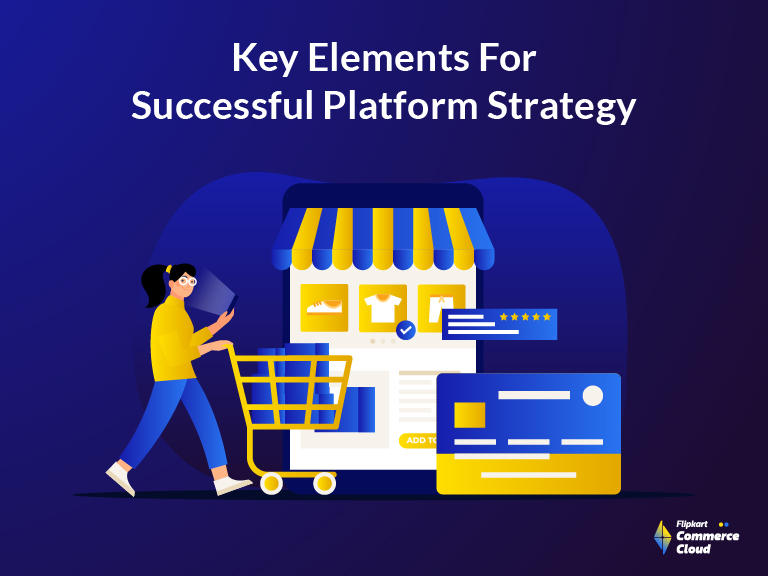
Your Retail Guide: Three Elements of a Successful Platform Strategy
By Flipkart Commerce Cloud
Share On:
In the heart of the modern digital economy, platform businesses are emerging as a powerful force. These businesses create value by connecting two or more related groups and are changing the way people think about commerce. With their ability to drive growth and innovation at an unmatched scale, platform businesses are becoming increasingly relevant each year.
As per a recent report from Forbes Advisor, the global e-commerce market, a significant portion of which comprises retail platform businesses, is expected to be worth $6.3 trillion in 2024, up from $5.8 trillion in 2023. This trend highlights the growth prospects of retail platforms and the need for targeted strategies to tap into this potential.
While technology is a key enabler, as a retailer, you must understand that successful platforms are built on a deep understanding of three elements: reliable workflows, exceptional customer service and data-driven tools. These components act as the foundational pillars for sustainable growth, ensuring seamless execution and maximizing the platform’s potential.
In this context, Flipkart Commerce Cloud (FCC) emerges as a prime example of a platform that embodies these principles. Catering to the distinct needs of retailers, FCC presents a comprehensive marketplace solution. At its core, FCC’s marketplace in a box integrates three key components – user experience, supply chain management, and the seller ecosystem, collectively known as the demand, supply, and seller pods for seamless marketplace operation.
What sets FCC apart is its high degree of customizability, which enables it to conform to business logic and market regulations, such as precise customer promise management and handling of regulated categories. Designed to operate at scale, FCC can efficiently manage millions of simultaneous transactions, guaranteeing reliable performance even under peak demand.
FCC pioneers innovative features like ‘headless’ solutions for cart and checkout processes, and a hybrid order management system for both online and offline stores. These offerings underscore FCC’s dedication to delivering state-of-the-art solutions that augment both the retailer’s operations and the customer’s shopping experience.
In the following sections, we will explore these three elements of a successful platform strategy and how they can drive growth for your business. Keep reading to learn more.
Understanding Platform Businesses
A platform business is an entity that offers a secure digital environment for the seamless exchange of goods and services between two or more interdependent groups (usually consumers and producers). These businesses do not directly create or control the exchange but focus on providing the framework and tools for those interactions to occur.
There are several types of platform models, including e-commerce marketplaces, social platforms, and innovation platforms, that you can choose from for your retail business.
- Marketplaces like Flipkart connect sellers and buyers, offering an extensive array of goods at competitive prices.
- Social networks and platforms like Facebook encourage connections, allowing users to share and engage with content, thereby creating a sense of community.
- Innovation platforms like Salesforce provide tools and services that enable businesses to innovate and grow.
These platforms, while diverse in their approach, all leverage the power of digital transformation and technological advancements. Digital transformation has opened new avenues for customer engagement, while technological advancements have provided the necessary tools and infrastructure for these platforms to thrive. This transition has led to the emergence of new business models and revenue streams, as companies like Walmart have discovered.
Key Features of Platform Businesses
Understanding the three elements of a successful platform strategy involves recognizing the following essential features that drive growth for platform businesses:
- User Engagement: Engaging users is essential for driving growth and sustaining the platform. Strategies for engagement include offering personalized experiences interactive features, and continuously seeking user feedback. For instance, social media platforms like Instagram often use gamification elements to boost user activity and engagement.
- Network Effects: As and when the number of users joining the platform grows, its value also increases. This phenomenon encourages user acquisition and retention through mechanisms like referrals, reviews, and social proof. An example of this can be seen in how eCommerce platforms like Flipkart leverage customer reviews to build trust and attract more users.
- Data Analytics: Platform businesses utilize user data to optimize operations, marketing, and product offerings. This involves advanced tools and techniques for collecting, processing, and analyzing important Key Performance Indicators (KPIs). A prime example is Netflix’s recommendation system, which uses viewing history and preferences to suggest content to users.
- Ecosystem Building: Successful platforms create a community of developers, partners, and users. This fosters innovation and provides additional value through third-party integrations and collaborations. Apple’s App Store ecosystem, which encourages developers to create apps for iOS users, is a perfect illustration of this feature.
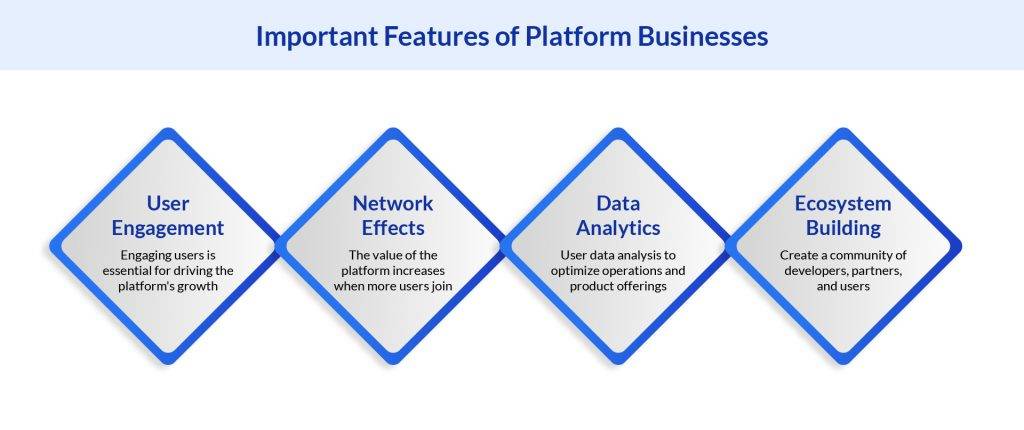
Why Digital Transformation is a Priority for Retailers?
In the extremely competitive retail market, digital transformation is not just an option but a necessity for your business. It offers numerous benefits, from operational efficiency and cost savings to improved customer experience and new revenue opportunities.
Here are some important aspects of digital transformation that make it a priority for your business:
- Operational Efficiency: It can help streamline your operations by automating tasks, improving supply chain processes, and enhancing inventory management. It enables you to allocate resources more strategically and enhance your overall operational efficiency.
- Enhanced Customer Experiences: Digital platforms allow you to provide personalized and seamless interactions to your customers. For instance, AI-powered recommendation systems can tailor product suggestions based on individual customer preferences, thereby enhancing their shopping experience.
- New Revenue Streams: Digital platforms can open new revenue streams by creating opportunities for innovative products and services. For example, by integrating third-party services, you can offer an extensive range of products and services to the customers, thereby increasing your revenue potential.
Take the example of Walmart, a leading retailer that has successfully embraced digital transformation. They have streamlined operations by leveraging data analytics for efficient inventory management and logistics. Furthermore, Walmart has explored new revenue opportunities, such as its online marketplace, which allows third-party sellers to reach its vast customer base. This transformation has not only boosted Walmart’s growth but also set a benchmark for retailers worldwide.
Stages of Platform Growth
Building a successful platform is a journey that includes various stages, each presenting unique challenges and opportunities:
Identify
The journey of building a successful platform begins with the identification stage. Here, you focus on understanding market needs and opportunities. Undertake detailed market research to know more about your customers’ needs, preferences, and pain points. Identify the target users and validate your platform idea by conducting surveys or interviews. For instance, Airbnb identified a niche need for affordable, homely accommodations, which was the foundation of their successful platform.
Build
Next comes the build stage, where you focus on developing the platform’s core features and functionalities. Prioritize building a user-friendly interface that makes it easy for users to navigate your platform. Invest in robust infrastructure to ensure your platform can handle increasing volumes of transactions as it grows. Initiate marketing efforts to attract early users. Flipkart, for example, started by building a simple online bookstore before expanding into the retail giant it is today.
Seed
The seed stage involves attracting and engaging initial users. Incentivize early adopters with exclusive offers or benefits. Build a community around your platform by encouraging user interaction and feedback. Create network effects by making your platform more valuable as more users join. Facebook, for instance, in the first step of its journey, seeded its platform among college students, providing an exclusive space for them to connect.
Scale and Monetize
In the scale and monetize stage, you focus on expanding the user base and enhancing the platform’s features. Implement monetization strategies such as subscription models, transaction fees, and advertising. Leverage customer feedback and data analytics regularly to improve the performance of your platform. LinkedIn, for example, has successfully scaled and monetized its platform through premium subscriptions and advertising.
Expand
Finally, in the expansion stage, the platform extends its reach and diversifies its offerings. Explore strategies for entering new markets, such as localizing your platform for different regions or partnering with local businesses. Add new services based on user needs and market trends. Leverage data for continuous improvement and innovation. Uber’s expansion into food delivery with Uber Eats is a prime example of this stage.
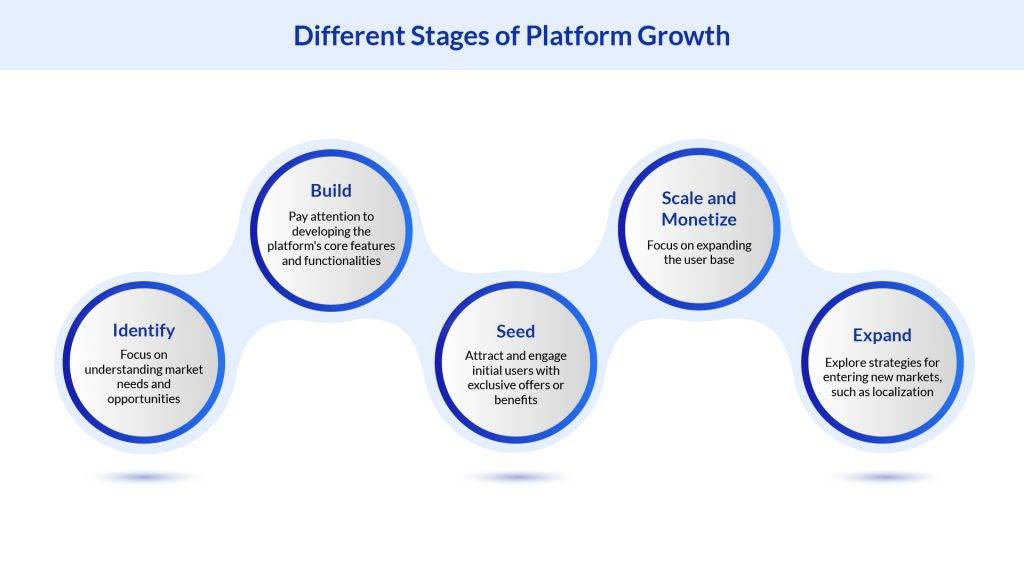
Three Elements of a Successful Platform Strategy
Here are three elements of a successful platform strategy that can help you optimize the performance of your business:
Reliable Workflows for Consistent Customer Success
Creating simple and reliable workflows for sellers is a cornerstone of a successful platform strategy. This process involves developing intuitive tools and robust backend systems that can enhance the seller experience and retention.
- Intuitive Seller Tools: These tools should be designed with the user in mind, ensuring they are easy to use and navigate. They should provide sellers with the ability to easily list their products, manage inventory, track sales, and handle customer queries. A good practice is to regularly update these tools based on seller feedback to ensure they continue to meet the sellers’ needs.
- Robust Backend Systems: These systems are the backbone of your platform, handling everything from order processing and payment handling to customer service and dispute resolution. They need to be robust and scalable to handle increasing volumes of transactions as your platform grows. Implementing best practices such as regular maintenance, data backup, and security measures can ensure the reliability of these systems.
- Personalized Seller Support: Providing ongoing support to sellers can enhance their experience and increase their preference for your platform. This could include dedicated support teams, personalized seller dashboards, or customized training programs. Use data analytics to understand seller behavior and preferences. This can help you make informed decisions about feature development, seller support, and platform improvements.
Crafting Exceptional Customer Experiences
Offering exceptional customer experiences is a vital element of a successful platform strategy. From the very beginning, your platform should be designed with the customer in mind.
- User-Friendly Design: A user-friendly design is not just about aesthetics; it’s about functionality. Your platform should be easy to navigate, with clear and intuitive interfaces. This can significantly enhance the user experience and encourage users to spend more time on your platform.
- Responsive Customer Support: Responsive customer support can make a world of difference in the user experience. Make sure that the users can easily reach out for help when they need it and that their concerns are addressed promptly and effectively.
- Personalized Experiences: Personalization is key to enhancing customer experience. By customizing the user experience according to individual preferences and behaviors, you can make your customers feel valued and understood. This could involve personalized product recommendations, tailored content, or customized user interfaces.
- Hybrid Cart for Omnichannel Shopping: A hybrid cart refers to a single shopping cart that enables consumers to shop across channels and reach their cart via phone, computer, or even in-store. For many shoppers, the mobile shopping cart has become a wish list, used to save items to their account that they go back to when purchasing in another channel, such as online or in-store. This feature can be a significant addition to your platform, providing a seamless omnichannel shopping experience for your customers.
Leveraging Data-Driven Tools for a Winning Sales Strategy
Data is the lifeblood of platform businesses. It provides valuable insights into user behavior, platform performance, and market trends, which can inform your sales strategy.
- Data Analytics: It involves collecting, processing, and analyzing user data to derive actionable insights. These insights empower you to better understand users, optimize your platform’s performance, and make informed decisions.
For example, you can integrate the FCC’s Pricing Engine into your data analytics process. It features three key modules that work in harmony to ensure your product pricing is tailored to market dynamics, enhancing customer price perception and maximizing revenue:
- Competitor Intelligence: Provides access to accurate and timely competitor data, enabling you to gain actionable insights and stay ahead of the competition.
- Rule-based Dynamic Pricing Engine: Allows you to set granular pricing rules and automate pricing for all SKUs at scale, ensuring dynamic and competitive pricing.
- Price Optimizer: Uses advanced machine learning algorithms and game theory models to help increase revenue and profitability through optimized pricing.
By harnessing the power of these modules, you will not be just reacting to the market dynamics but proactively shaping them to maximize your revenue and enhance customer price perception.
- Predictive Analytics: It involves analysis of past data to determine future trends and behaviors. This can help you anticipate market changes, identify opportunities, and mitigate risks. Use a diverse set of data sources to improve prediction accuracy and continuously update your models as new data becomes available.
- Data Visualization: These tools can help present your data in a visually appealing format. This can make it easier for you and your team to interpret the data and make data-driven decisions. For instance, a well-designed dashboard can provide a real-time overview of your platform’s performance, helping you to quickly identify and respond to issues.
How Flipkart Commerce Cloud Can Help Optimize Your Platform Strategy?
Flipkart Commerce Cloud (FCC) offers a suite of solutions designed to support platform businesses, particularly in the ecommerce and marketplace sector. Leveraging Flipkart’s extensive knowledge of the ecommerce market and its advanced technology, FCC provides a range of solutions trained and optimized on billions of data points after over 25+ million engineering hours to help you build and scale a successful platform.
One of FCC’s key offerings is our ability to build the entire marketplace for you. With over 15+ years of experience, FCC can customize the marketplace to cater specifically to your needs and those of your customers. This means you get a platform tailored to your business, helping you stand out in the competitive retail landscape and experience a 5-10% revenue uplift and a 7-15% margin improvement.

Our retail solutions include the entire marketplace technology stack, retail media solutions, pricing solution, inventory management, and forecasting solutions. Each solution has been created with the help of the latest technology and is scale-tested at Flipkart every day. These solutions can help you grow your business reliably and securely.
At FCC, we are more than just a technology provider; we are your partners. We offer comprehensive consultation services throughout your business partnership journey, providing expert guidance and support every step of the way.
To learn more about how FCC can help optimize your platform strategy, get in touch with our experts today.
More Blogs
See how retailers and brands are winning with FCC
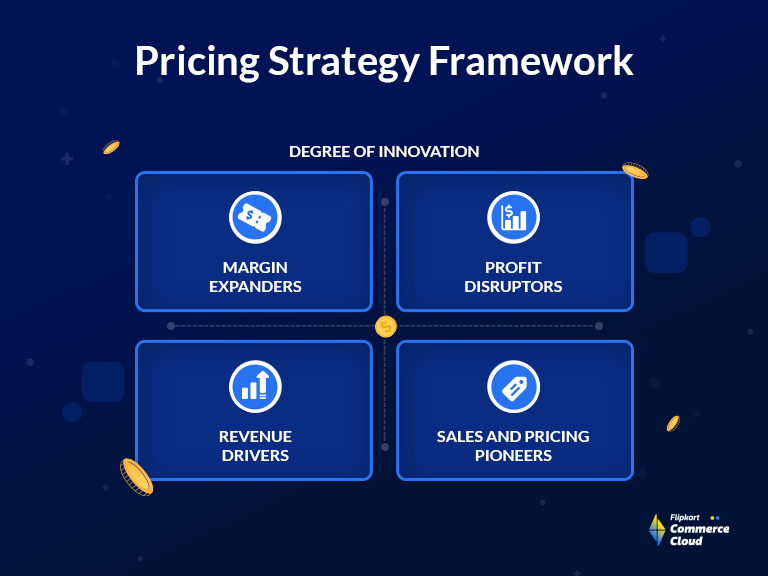
Mastering Pricing Strategy Framework
Read More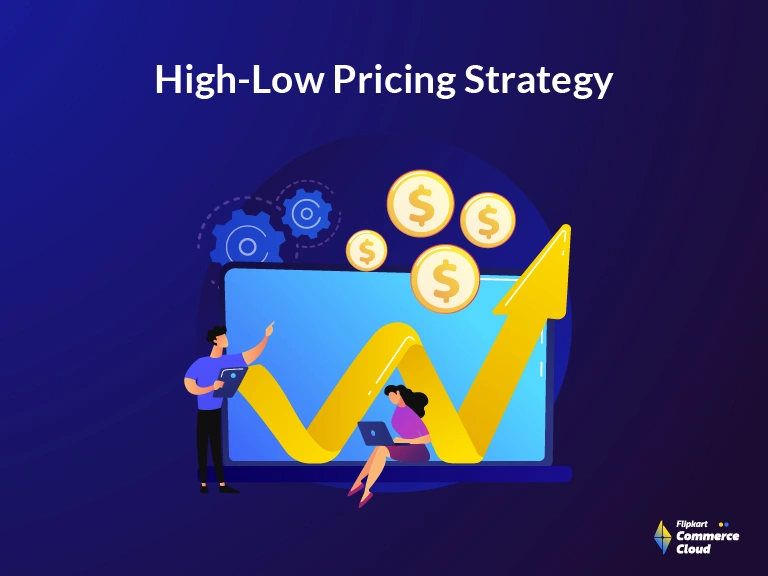
What is a High-Low Pricing Strategy?
Read More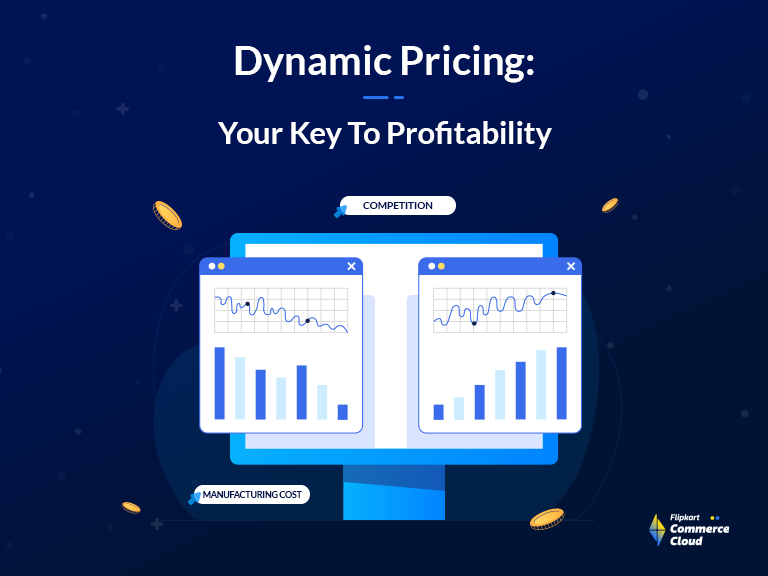
Ultimate Guide To Dynamic Pricing Strategy In 2025
Read More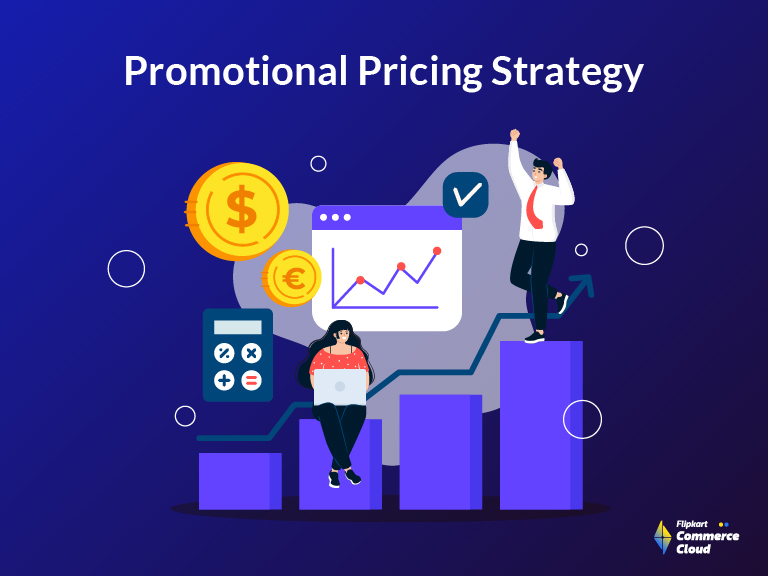
Retail Pricing Strategies: Winning with Promotion Pricing in Competitive Markets
Read More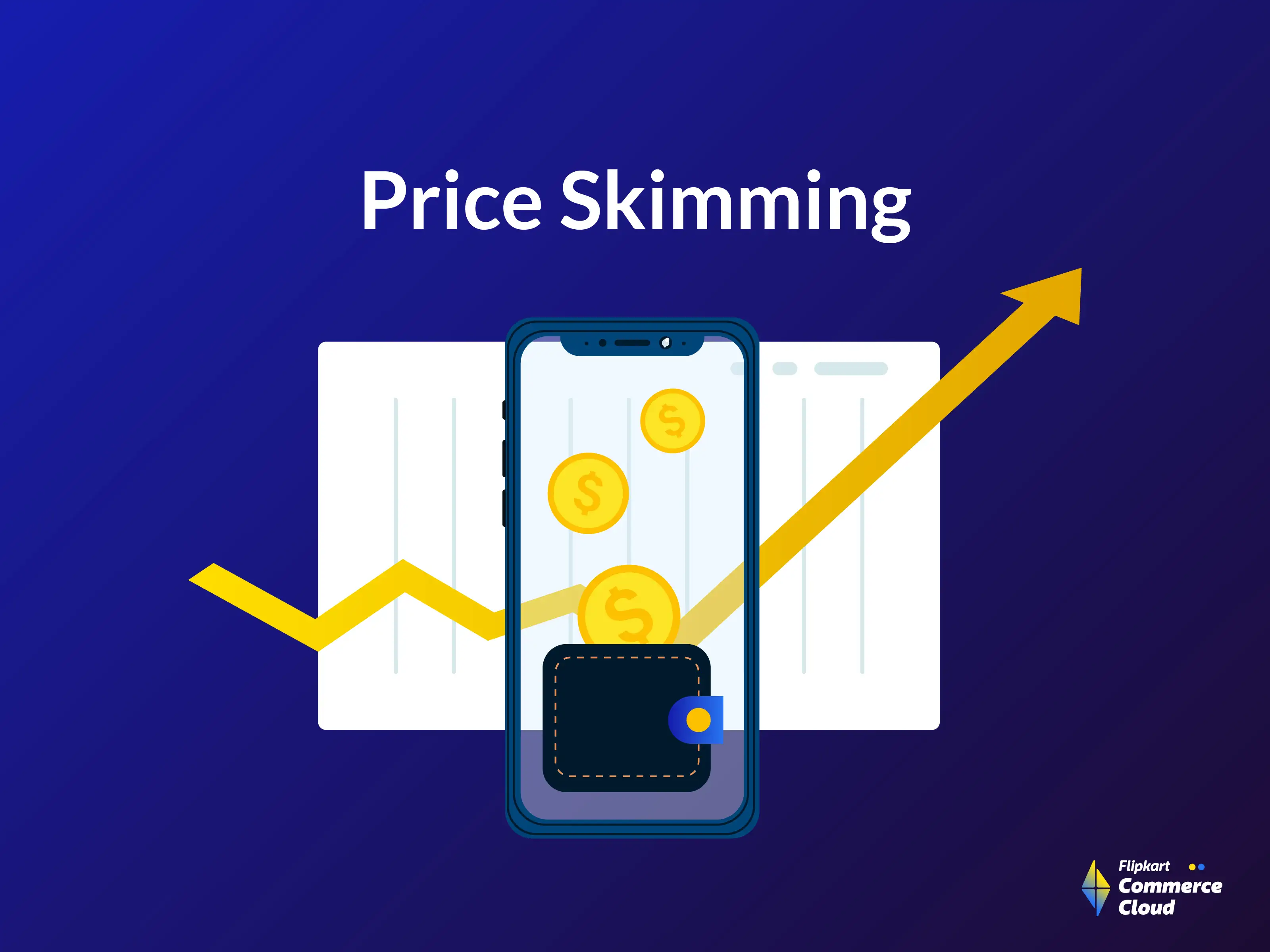
Everything About Price Skimming Strategy Explained
Read More
Mastering Pricing Strategy Framework
Read More
What is a High-Low Pricing Strategy?
Read More
Ultimate Guide To Dynamic Pricing Strategy In 2025
Read More
Retail Pricing Strategies: Winning with Promotion Pricing in Competitive Markets
Read More
Everything About Price Skimming Strategy Explained
Read More
Mastering Pricing Strategy Framework
Read More
What is a High-Low Pricing Strategy?
Read More
Ultimate Guide To Dynamic Pricing Strategy In 2025
Read More
Retail Pricing Strategies: Winning with Promotion Pricing in Competitive Markets
Read More